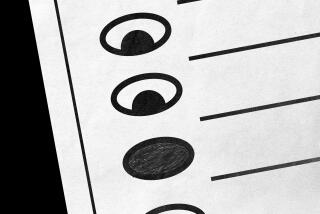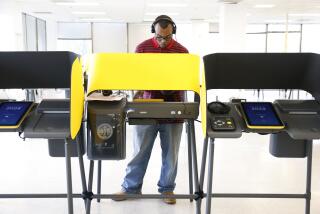Opinion: Missing: Fringe political parties under the top-two primary system

So, is the electoral deck stacked even more for Democrats and Republicans under California’s top-two primary system? Judging by the secretary of state’s Statement of Vote released Monday for the June 3 primaries, the answer is, yes.
It turns out the top-two primary means a thinner, less diverse ballot both in the primaries and in the November general election, which was anticipated by critics of the approach. This is the system under which only the top-two finishers in a primary, regardless of party affiliation, continue on to the general election.
As the Public Policy Institute of California’s Mark Baldassare points out, seven of the eight statewide races in November will feature showdowns between one Republican and one Democrat (the nonpartisan school superintendent’s race will be between two Democrats). But there will be no additional Green Party candidates, nor the Peace and Freedom folks, American Independents or Libertarians on the ballot.
I, for one, will miss them.
Primary elections, as we all know, tend to draw light voter turnout. Under a top-two system, minor-party candidates theoretically have a fighting chance to make the cut for the general election. If a crowded field of Democrats or Republicans divides the electorate, that gives a fringe candidate a chance to make the cut and offer voters in the general election a clear alternative to a major party.
But it didn’t work out that way. With 16 active candidates, the most crowded field in the Los Angeles area was for the 33rd Congressional District seat being vacated by the retiring Henry Waxman. The final two? A Republican, Elan Carr, and a Democrat, Ted Lieu. And none of the statewide unaligned candidates – most notably former Republican and current independent Dan Schnur in the secretary of state race – drew much support, either. In fact, Schnur received fewer votes than Democratic state Sen. Leland Yee, who withdrew from the race after being arrested on gun-running and corruption charges.
So the net effect seems to be a further marginalizing of candidates from outside the major parties. Of the state’s registered voters, 43% are registered Democrats and 28% are Republicans, which leaves about 30% of voters either unaligned or belonging to the fringe parties.
So what does this mean for the general election? Less incentive for non-major party voters to turn out. If you don’t like the major parties, you won’t get the chance to cast a protest vote for the Peace and Freedom or Libertarian candidate. And why vote for one of major parties if you believe it just encourages them?
Interestingly, June’s voter turnout in Los Angeles, San Bernardino, Riverside and Orange counties fell behind the statewide average of 25% of registered voters. Among eligible voters, the statewide turnout rate was 18%, or fewer than one in five people who had a right to vote. This despite an easy-to-use vote-by-mail system.
In numerical terms, that means a population smaller than that of Los Angeles County makes the key electoral decisions for the entire state. A representative democracy whose politicians are picked by only a sliver of the electorate isn’t much of a democracy. As the old saying goes, we get the government we deserve.
Follow Scott Martelle on Twitter @smartelle
More to Read
A cure for the common opinion
Get thought-provoking perspectives with our weekly newsletter.
You may occasionally receive promotional content from the Los Angeles Times.











